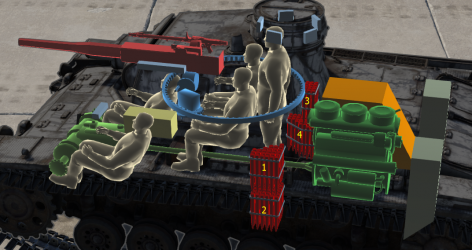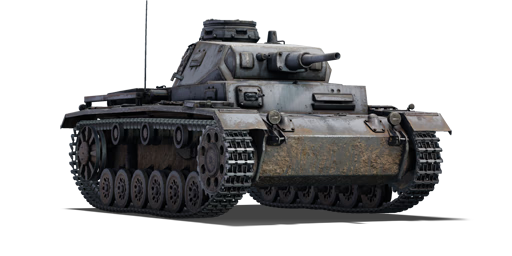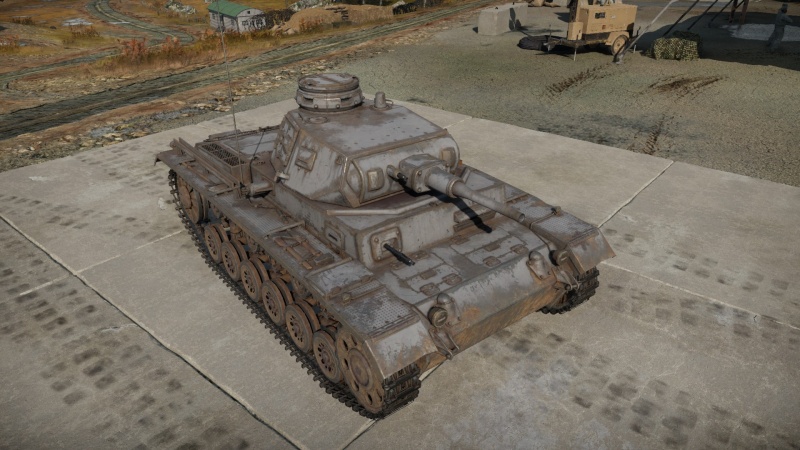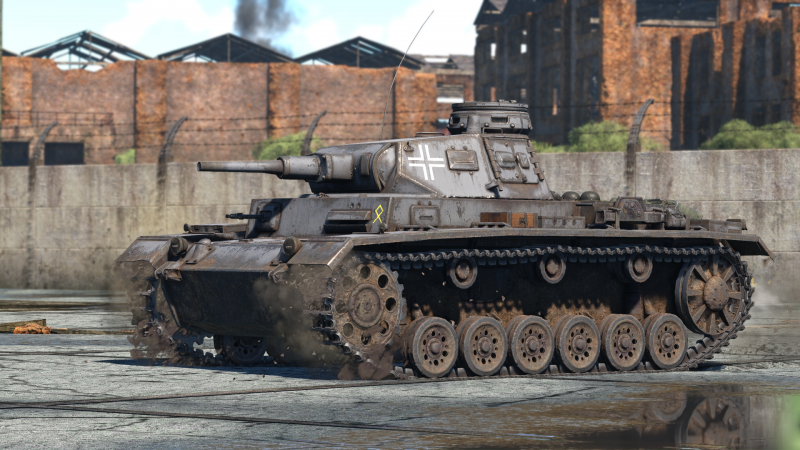Difference between revisions of "Pz.III F"
U168221799 (talk | contribs) m (added note about rack magazines) (Tag: Visual edit) |
(→Ammo racks) |
||
| Line 99: | Line 99: | ||
'''Note''': | '''Note''': | ||
| − | * Racks disappear after | + | * Racks only disappear after all shells in the rack have been fired. |
* Turret empty: 32 ''(+67)'' shells. | * Turret empty: 32 ''(+67)'' shells. | ||
Revision as of 12:28, 16 March 2024
| This page is about the German medium tank Pz.III F. For other versions, see Panzer III (Family). |
Contents
Description
The Panzerkampfwagen III Ausführung F (Panzer III F) (Sd.Kfz. Index: Sd.Kfz. 141) is the sixth variant of the Panzerkampfwagen III medium tank family. The Panzer III F, which succeeded the Panzer III E as the next medium tank in the Panzer III medium tank family, was largely an improved variant with a few crucial upgrades and adjustments. Notably, in addition to the Panzer III E's new torsion bar suspension system, making it easier and cheaper to build and repair in combat, it also mounted a new 50 mm Kampfwagenkanone (KwK) 38 L/42 tank gun which significantly increased its firepower. The Panzer III F saw a greater quantity of production than the Panzer III E, with over 400 units produced between 1939 and 1941. As a result, it was one of the most numerous Panzer IIIs, and it played an important part in the early phases of World War II, beginning with the invasion of the West in May 1940.
Introduced in the Closed Beta Test for Ground Forces before Update 1.41, the Panzer III F variant is a completely novel design that replaces the earlier Panzer III E variant. First, it was outfitted with the new 50 mm KwK38 L/42 tank gun, which considerably increased its firepower and put it on pace with other nations at the time. Second, with the addition of torsion bar suspension, the Panzer III F became far more reliable. The tank is made up of armour plates ranging in thickness from 20 to 30 mm. Despite their vulnerability, higher firepower allows players to take more risks and engage foes with more dependability and ease. However, since almost no Panzer IIIs had their turret traverse upgraded to an electric power drive system, it is advised not to be too aggressive on the battlefield.
General info
Survivability and armour
Armour type:
- Rolled homogeneous armour
- Cast homogeneous armour (Cupola)
| Armour | Front (Slope angle) | Sides | Rear | Roof |
|---|---|---|---|---|
| Hull | 30 mm (11°) Front plate 25 mm (85°), 30 mm (53°) Front glacis 30 mm (22-72°) Lower glacis |
30 mm | 10 mm (74°), 20 mm (33-70°) Top 20 mm (11-66°) Bottom |
10 mm |
| Turret | 30 mm (14-30°) Turret front 37 + 37 mm (5-52°)Gun mantlet |
30 mm (17-26°) | 30 mm (0-23°) | 10 mm |
| Armour | Sides | Roof | ||
| Cupola | 30 mm | 10 mm |
Notes:
- Suspension wheels are 15 mm thick while tracks are 20 mm thick.
- The barrel shroud around the main gun is 20 mm thick.
- Bustle racks on the rear hull sides give another 30 mm thick armour at their locations.
- Belly armour is 15 mm thick.
Mobility
| Game Mode | Max Speed (km/h) | Weight (tons) | Engine power (horsepower) | Power-to-weight ratio (hp/ton) | |||
|---|---|---|---|---|---|---|---|
| Forward | Reverse | Stock | Upgraded | Stock | Upgraded | ||
| Arcade | Expression error: Unexpected * operator. | 465 | Expression error: Unexpected round operator. | __.__ | |||
| Realistic | 265 | Expression error: Unexpected round operator. | __.__ | ||||
Modifications and economy
Armaments
Main armament
| 50 mm KwK L/42 | Turret rotation speed (°/s) | Reloading rate (seconds) | |||||||||||
|---|---|---|---|---|---|---|---|---|---|---|---|---|---|
| Mode | Capacity | Vertical | Horizontal | Stabilizer | Stock | Upgraded | Full | Expert | Aced | Stock | Full | Expert | Aced |
| Arcade | 99 | -10°/+20° | ±180° | N/A | 5.24 | 7.25 | 8.80 | 9.73 | 10.35 | 5.20 | 4.60 | 4.24 | 4.00 |
| Realistic | 3.27 | 3.85 | 4.67 | 5.17 | 5.50 | ||||||||
Ammunition
- PzGr 39 - Armour Piercing Capped shell - This is the main ammo type, use it whenever it has enough penetration to penetrate the target. It deals the most damage, because of its explosive filler. On this tank, most of the time it is not necessary to use any other type of ammo.
- PzGr 40 - Armour Piercing Composite Rigid shell - This type of ammo should be used if the gun is having trouble penetrating the opponent, or trying to hit a fast-moving tank at some distance. However, its damaging potential is much lower, because it has no explosive filler to further enhance damage after the penetration. It is also much lighter than Gr 39, so it loses penetration faster over distance. It is also notable that it does not ricochet so easily from highly sloped armour.
| Penetration statistics | |||||||
|---|---|---|---|---|---|---|---|
| Ammunition | Type of warhead |
Penetration @ 0° Angle of Attack (mm) | |||||
| 10 m | 100 m | 500 m | 1,000 m | 1,500 m | 2,000 m | ||
| PzGr 39 | APC | 80 | 76 | 62 | 48 | 38 | 29 |
| PzGr 40 | APCR | 116 | 107 | 74 | 47 | 30 | 19 |
| Shell details | ||||||||||||
|---|---|---|---|---|---|---|---|---|---|---|---|---|
| Ammunition | Type of warhead |
Velocity (m/s) |
Projectile mass (kg) |
Fuse delay (m) |
Fuse sensitivity (mm) |
Explosive mass (TNT equivalent) (g) |
Ricochet | |||||
| 0% | 50% | 100% | ||||||||||
| PzGr 39 | APC | 685 | 2.05 | 1.2 | 9 | 28.9 | 48° | 63° | 71° | |||
| PzGr 40 | APCR | 1,050 | 0.9 | - | - | - | 66° | 70° | 72° | |||
Ammo racks

| Full ammo |
1st rack empty |
2nd rack empty |
3rd rack empty |
4th rack empty |
Visual discrepancy |
|---|---|---|---|---|---|
| 99 | 73 (+26) | 47 (+52) | 32 (+67) | 0 (+99) | No |
Note:
- Racks only disappear after all shells in the rack have been fired.
- Turret empty: 32 (+67) shells.
Machine guns
| 7.92 mm MG34 | ||||
|---|---|---|---|---|
| Mount | Capacity (Belt) | Fire rate | Vertical | Horizontal |
| Coaxial | 4,350 (150) | 900 | N/A | N/A |
Usage in battles
This tank should be played as second-line support or area denial vehicle, due to its acceptable speed and its accurate, potent gun, yet sluggish turret traverse even when fully upgraded. Avoid engagements at less than 500 m, where the armour offers more protection against low-velocity guns and the 50 mm cannon retains its penetration well. Always try to use the terrain to the Panzer III's advantage, it has a very nice gun depression so the Panzer III will have no problem with attacking over hills and various obstacles while hiding the vulnerable hull.
The Pz.III F's most challenging opposition will be B1 bis and the B1 ter. These will demand heavy use of APCR to deal with in frontal confrontations, and might demand APCR for even side shots.
For a more aggressive playstyle, this tank can be an advantageous point capturer. Immediately spawning into the map and charging to a point to capture, you will likely surprise enemy light tanks with your thicker armour and more potent weapon. Watch your flanks, but proper angling should mitigate the risk.
Pros and cons
Pros:
- Accurate and decently powerful gun
- Great gun depression
- Very high shell velocity for both APCR rounds (over 1,000 m/s)
- Good mobility
- Armour is fairly decent; it will protect the tank against 37 mm guns at range and 20 mm cannon at all ranges if angled properly
Cons:
- Awful turret traverse speed due to the hand-cranked turret
- Flat armour with little slope
- Low reverse speed
History
Development
The Panzerkampfwagen III medium tank or the Panzer III was developed in the 1930s. Starting in early 1934, Heinz Guderian set down some specifications for a new tank, which Army Weapons Department took up to design the tank to weigh no more than 24,000 kg with a top speed of 35 km per hour. This tank's role was to be the main tank of the German army and was expected to destroy opposing tanks, as opposed as a tank made to destroy anti-tank guns and opposing infantrymen, which the Panzer IV took up in.
Daimler-Benz, Krupp, MAN, and Rheinmetall produced prototypes meeting the specifications and the Daimler-Benz model was chosen after testing in 1936-1937. The Panzer III model used a leaf-spring suspension in its early models (Ausf. A - Ausf. D) before utilizing a six-wheeled torsion-bar suspension in the Ausf. E and beyond. The Panzer III had a crew of five people, the commander, gunner, loader, driver, and assistant driver. The best feature of the Panzer III during its introduction that is the most overlooked was the three-man turret, which was not as common at the time. This frees the commander to be able to effectively command the tank while maintaining situational awareness rather than be burdened by the role of a loader or gunner, improving the combat effectiveness of the tank. Despite this rather advanced design, the turret did not have a turret basket for the crew. It was a proven design and production began in May 1937. The total number of Panzer IIIs tanks constructed in its production life was 5,774 units (excluding StuG III variant).
Specifications
The Panzer III Ausf. A through C had 15 mm of armour on all sides with 10 mm on top and 5 mm on the bottom. This was quickly upgraded to 30 mm on front, side, and rear on the Ausf. D, E, F, and G models. The Panzer III Ausf. F featured a 50 mm KwK38 cannon, an upgrade over the previous 37 mm KwK36. The Panzer Ausf. F had a 300 PS Maybach HL 120 TRM engine that gave it a top speed of about 40 km/h (25 mph) with an operational range of 155 km (96 mi.).
Combat Usage
The Panzer III Ausf. F was first prompted by the German army concerns of their tank-killing tank being under-gunned during the French campaign, where the appearance of the French Char B1 and British Matilda tanks proved that their current arsenal was inadequate to counter these threats. Though it was initiated during the campaign, it was over before it could be fully implemented among the armoured forces. It wasn't until Operation Barbarossa, where the appearance of the Soviet T-34 and KV-1 tanks forced the Germans to take up better weapons for their anti-tank inventory. The solution was the 50 mm KwK38, which helped the Panzer III be able to destroy these Soviet tanks with APCR rounds. Even though the newer Soviet tanks may put the Panzer III out of frontline duties, it still stayed as the more common Soviet T-26 and BT series light tanks were more easily destroyed by the Panzer III.
The German army continued to upgrade their Panzer III to keep them in service as long as possible. The Panzer III Ausf. H featured another 30 mm of armour applied to the original 30 mm of armour on the hull. The next significant upgrade was to the Panzer III Ausf. J, which featured a solid 50 mm of frontal and rear armour plating.
| Archive of the in-game description | |
|---|---|
|
The Pz.Kpfw. III Ausf. F variant, produced from September 1939 to July 1940, had some minor differences from the Pz.Kpfw. III Ausf. E. Armoured covers were installed over the air intakes used to cool the tank's steering mechanism and brakes. Also, a modified Maybach HL 120TRM engine was installed. Special angled screens were installed in front of the base of the turret to protect its rotation mechanism from being hit by a projectile and jamming. Some electrical equipment was also added, including positional lights on its edges, two lights on its tow hitches, and a Notek headlight on its left side. Together, the Alkett, Daimler-Benz, FAMO, MAN and Henschel companies built 435 of these tanks. The experience of the Polish campaign convinced the troops of the need for tanks with more powerful weaponry than a short-barreled 37 mm gun. Therefore, in June 1940, the first 10 Ausf. F tanks were built, equipped with 50 mm 5 cm KwK38 L/42 guns, with a reworked gun mantlet and front section of the turret. The second round of the tank's modernization was conducted from 1942 to 1943, when the vehicles received long-barreled 5 cm KwK39 L/60 guns. Some variant Ausf.F tanks remained in service for quite some time. One of the last of the machines, operated by the 116th Panzer Division, was destroyed in Normandy in June 1944. Captured Pz.Kpfw. III Ausf. F tanks were actively used by the Red Army. Test results from the Kubinka firing ground made a good impression on Soviet military leadership. The Soviet Union recognized this tank as the best foreign tank in its class, as far as mobility, crew safety, and ease of operation were concerned. | |
Media
- Skins
- Sights
See also
Links to the articles on the War Thunder Wiki that you think will be useful for the reader, for example:
- reference to the series of the vehicles;
- links to approximate analogues of other nations and research trees.
External links
Paste links to sources and external resources, such as:
- topic on the official game forum;
- other literature.
| Germany medium tanks | |
|---|---|
| Pz.III | Pz.III B · Pz.III E · Pz.III F · Pz.III J · Pz.III J1 · Pz.III J1 TD · Pz.III L · Pz.III M · Pz.III N |
| Pz.IV | Pz.IV C · Pz.IV E · Pz.IV F1 · Pz.IV F2 · Pz.IV G · Pz.IV H · Pz.IV J · Pz.Bef.Wg.IV J |
| Pz.V | VK 3002 (M) · Panther A · Panther D · Panther F · Panther G · Ersatz M10 · Panther II |
| M48 upgrades | M48A2 G A2 · M48 Super |
| Leopard 1 | Leopard I · Leopard A1A1 · Leopard A1A1 (L/44) · Leopard 1A5 · C2A1 · Turm III |
| Leopard 2 | PT-16/T14 mod. · Leopard 2K · Leopard 2AV |
| Leopard 2A4 · Leopard 2 (PzBtl 123) · Leopard 2A4M · Leopard 2 PL · Leopard 2A5 · Leopard 2 PSO · Leopard 2A6 · Leopard 2A7V | |
| Trophies | ▀M4 748 (a) · ▀T 34 747 (r) |
| Other | Nb.Fz. · KPz-70 |
| USA | mKPz M47 G · M48A2 C |
| USSR | ◊T-72M1 |






